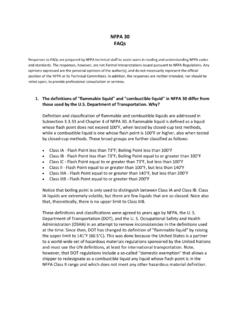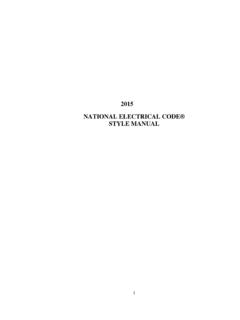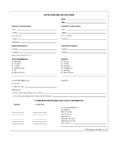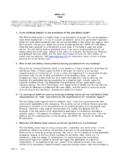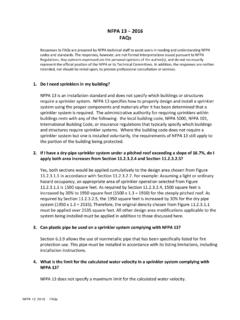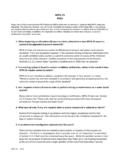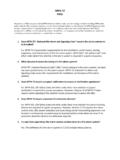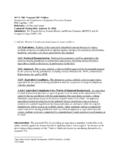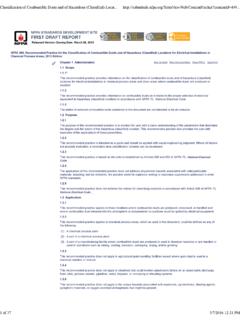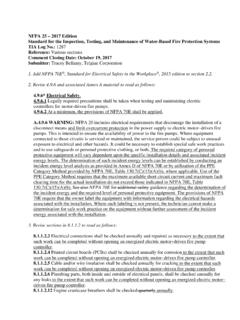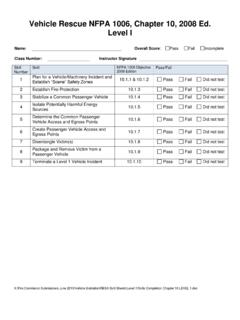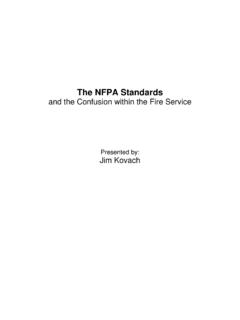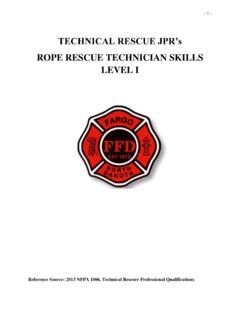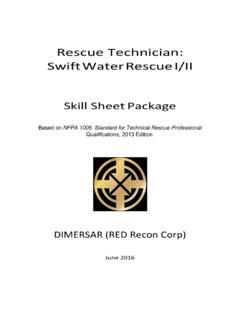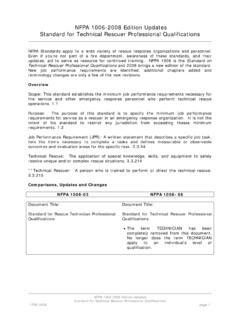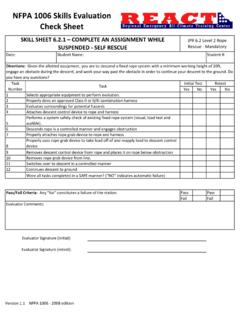Transcription of Technical Committee on Rescue Technician Professional ...
1 Technical Committee on Rescue Technician Professional Qualifications Report on Comment ( nfpa 1006) March 21, 2012 Conference Call (877) 320 2367 PIN 9414852 (updated pin) Live Meeting 11:00 AM ET Agenda 1. Call to Order Chair Mick Mayers 2. Introduction of Members and Guests 3. Chair s Remarks and Purpose of Meeting 4. Review of Minutes from Previous Meeting 5. Committee Procedures Staff Liaison Tom McGowan a. nfpa Codes and Standards Making Process ROC b. ProQual JPR Format c. Document Cycle Information d. nfpa Updates 6. Review of ROP Technical Committee a. Review of Public Comments and Actions b. Committee Comments and Action 7. Adjourn at the Close of Business nfpa 1006 Page 1 Minutes July 29-30, 2011 nfpa 1006 Professional Qualifications for Technical Rescuers ROP Meeting Baltimore, MD July 29-30, 2011 Meeting Minutes July 29, 2011 Convene 09:15 Attendance: - Committee Chair: Michael Mayers - Secretary: Richard Wright - nfpa Liaison: Tom McGowan - Attendance Roster: o In attendance - Principals Michael Mayers Francis Brennan Michael Carpenter Thomas Connell II Joshua Gillis Richard Karasaki Timothy Kovacs Glenn Mate Jeff Matthews J.
2 Michael McCreary Robert Rhea Brian Rousseau Steven Treinish Charles Wehrli Ernest Richey Wright o Alternates: Fred Jackson Peter Schecter o Conference Call: Ralph DeLuca o Visitors: Dale Dittrick Department of Commerce Pat Furr The Roco Corporation Pete Gannon Florida State Fire College and Dive Rescue International Call to Order by Committee Chair o Moment of silence for fallen brothers and Committee associates - Introductions - Sign-in and Committee Profile Update - Note of Gratitude to Committee members assisting nfpa with clarifications of the document over past two years. Others assisted that are not specifically mentioned Thanks to all! Old Business o Accept Previous Minutes nfpa 1006 Page 2 Minutes July 29-30, 2011 New Business - nfpa Liaison Introduction and Orientation Tom McGowan - Review nfpa Codes and Standards Tom McGowan - Review nfpa JPR Format Tom McGowan - ROP Review o All Public Proposals Reviewed Established sub-committees to review relevant Public comments Sub- Committee Assignments: o Water o Collapse o Rope Mine/Tunnel General Proposals addressed by entire Committee Chapter specific proposals addressed by sub-committees and presented to entire Committee for action o Committee acted on Proposals o TIA discussed Motion to Adjourn 17.
3 30 nfpa 1006 Professional Qualifications for Technical Rescuers ROP Meeting Baltimore, MD July 29-30, 2011 Meeting Minutes July 30, 2011 Pre-meeting Presentation 08:15 - Federal Emergency Management Administration (FEMA) National Incident Management System (NIMS) Search and Rescue (SAR) Presentation - Orientation Presentation by Timothy Kovacs Convene 09:35 Attendance: - Committee Chair: Michael Mayers - Secretary: Richard Wright - nfpa Liaison: Tom McGowan - Attendance Roster: o In attendance - Principals Michael Mayers Francis Brennan Michael Carpenter Thomas Connell II Joshua Gillis Richard Karasaki Timothy Kovacs Glenn Mate Jeff Matthews J. Michael McCreary nfpa 1006 Page 3 Minutes July 29-30, 2011 Robert Rhea Brian Rousseau Steven Treinish Charles Wehrli Ernest Richey Wright o Alternates Fred Jackson Peter Schecter o Visitors: Dale Dittrick Department of Commerce Pat Furr The Roco Corporation Pete Gannon Florida State Fire College and Dive Rescue International Call to Order by Committee Chair - Sign-in New Business Continued - Proposal action Continued - Committee Proposals acted on 18:05 Motion to Adjourn - Carried Report on Comments November 2012 nfpa 1006_____1006- Log #4 PQU-RES_____Christian Grand'Maison, Quebec National Fire Academy1006-3 Revise text to read as follows.
4 Rescuers at Levell and Level II shall remain current with Technical Rescue practices, and applicable standards, anddemonstrate competency on an annual scope of a pro qual standard is to establishes the minimum job performance requirementsnecessary for fire service and other emergency response personnel. I think that the Committee is beyond the scope ofthe standard by including an annual mandatory frequency for the competency topic should be discuss with the nfpa 1670 Committee . In fact, the demonstration competency should be writtenas a recommendation and not an Log #5 PQU-RES_____Eric J. Rickenbach, Keystone Fire Company1006-26 Revise text to read as follows:As used in this standard, the term vehicle means all passenger cars; light, medium, and heavy-dutytrucks and keeping with the proposal to separate vehicles into their own category, a definition of the termvehicle should be added to narrow the scope and applicability of this chapter to specifically those in the definition.
5 Asnoted in the ROC, vehicle Rescue is becoming the most Technical form of Rescue and this chapter should concentrate onthis area on 3/8/2012 Report on Comments November 2012 nfpa 1006_____1006- Log #1 PQU-RES_____Donald Cooper, State Fire Marshal, State of Ohio1006-9 Revise text to read as follows:Direct a team in the operation of a simple rope mechanical advantage system in a low-angle raising operation,given Rescue personnel, a minimum load haul distance of 3 m (10 ft)a specified minimum travel distance for the load,anestablished rope Rescue system incorporating a simple rope mechanical advantage system, a load to be moved, and ananchor system, so that the movement is controlled, a reset is accomplished, the load can be held in place when needed,operating methods do not stress the system to the point of failure, commands are used to direct the operation, andpotential problems are identified, communicated, and specified minimum travel distance will vary based on the response area and the discipline-specificapplication.
6 The distance traveled should accurately depict the typical distance which would be experienced by theperson performing the skill and the operational components of the entire system be fully utilized ( , commands,progress capture, reset mechanisms). For example, an appropriate minimum travel distance for a Technical rescuer inthe urban/industrial environment for a low-angle raising operation may be 10-20 feet, while the minimum for thewilderness/cave environment may be considerably more at 30-50 a team in the operation of a simple rope mechanical advantage system in a high-angle raising operation,given Rescue personnel, an established rope Rescue system incorporating a simple rope mechanical advantage system,a minimum load haul distance of 3 m (10 ft)
7 A specified minimum travel distance for the load,a load to be moved, andan anchor system, so that the movement is controlled, a reset is accomplished, the load can be held in place whenneeded, operating methods do not stress the system to the point of failure, commands are used to direct the operation,and potential problems are identified, communicated, and specified minimum travel distance will vary based on the response area and the discipline-specificapplication. The distance traveled should accurately depict the typical distance which would be experienced by theperson performing the skill and the operational components of the entire system be fully utilized ( , commands,progress capture, reset mechanisms).
8 For example, an appropriate minimum travel distance for a Technical rescuer inthe urban/industrial environment for a high-angle raising operation may be 10-20 feet. while the minimum for thewilderness/cave environment may be considerably more at 30-50 as a litter tender in a low-angle lowering or hauling operation, given a rope Rescue system, a minimumlower or haul distance of m (20 ft)a specified minimum distance for the litter tender,life safety harnesses, litters,bridles, and specialized equipment necessary for the environment, so that risks to victims and rescuers are minimized,the means of attachment to the rope Rescue system is secure , and the terrain is negotiated while minimizing risks toequipment or specified minimum travel distance will vary based on the response area and the discipline-specificapplication.
9 The distance traveled should accurately depict the typical distance which would be experienced by theperson performing the skill and the operational components of the entire system be fully utilized ( commands,progress capture, reset mechanisms). For example, an appropriate minimum travel distance for a Technical rescuer inthe urban/industrial environment for a low-angle lowering or raising operation may be 10-20 feet, while the minimum forthe wilderness/cave environment may be considerably more at 30-50 a lowering operation in a low-angle environment, given Rescue personnel, an established loweringsystem, a minimum load travel distance of 3 m (10 ft)a specified minimum travel distance for the load,and a load to bemoved, so that the movement is controlled, the load can be held in place when needed, operating methods do not stressthe system to the point of failure, rope commands are used to direct the operation, and potential problems are identified,communicated, and specified minimum travel distance will vary based on the response area and the discipline-specificapplication.
10 The distance traveled should accurately depict the typical distance which would be experienced by theperson performing the skill and the operational components of the entire system be fully utilized ( , commands,progress capture, reset mechanisms). For example, an appropriate minimum travel distance for a Technical rescuer inthe urban/industrial environment for a low-angle lowering operation may be 10-20 feet, while the minimum for thewilderness/cave environment may be considerably more at 30-50 a lowering operation in a high-angle environment, given Rescue personnel, an established loweringsystem, a minimum load travel distance of 3 m (10 ft)a specified minimum travel distance for the load,and a load to bemoved, so that the movement is controlled, the load can be held in place when needed, operating methods do not stress2 Printed on 3/8/2012 Report on Comments November 2012 nfpa 1006the system to the point of failure, rope commands are used to direct the operation, and potential problems are identified,communicated, and specified minimum travel distance will vary based on the response area and the discipline-specificapplication.
